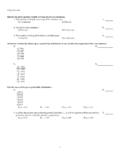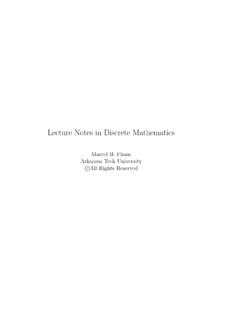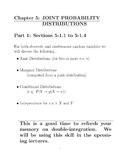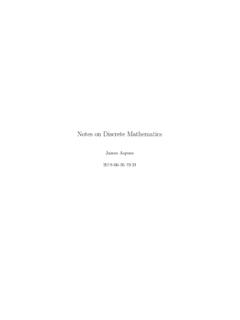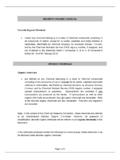Transcription of A visual introduction to Riemannian curvatures …
1 A visual introduction to Riemannian curvatures and somediscrete generalizationsYann try to provide a visual introduction to some objects used inRiemannian geometry: parallel transport, sectional curvature , Ricci curvature ,Bianchi We then explain some of the strategies used to define ana-logues of curvature in non-smooth or discrete spaces, beginningwith Alexan-drov curvature and -hyperbolic spaces, and insisting on various notions ofgeneralized Ricci curvature , which we briefly first part of this text covers in a hopefully intuitive andvisual way some ofthe usual objects of Riemannian geometry: parallel transport, sectional curvature ,Ricci curvature , the Riemann tensor, Bianchi For each of those we tryto provide one or several pictures that convey the meaning (or at least one possibleinterpretation) of the formal , we consider the problem of defining analogues of curvature for non-smooth or discrete objets.
2 This is in the spirit of synthetic or coarse geometry, inwhich large-scale properties of metric spaces are investigated instead of fine small-scale properties; one of the aims being to be impervious to small perturbations ofthe underlying space. Motivation for these non-smooth or discrete extensions oftencomes from various other fields of mathematics, such as grouptheory or optimaltransport. From this viewpoint is emerging a theory ofmetric measure spaces, seefor instance [Gro99].Thus we cover the definitions and mention some applications of -hyperbolicspaces and Alexandrov curvature (generalizing sectional curvature ), and of two no-tions of generalized Ricci curvature :displacement convexity of entropyintroducedby Sturm and Lott Villani (following Renesse Sturm and others), andcoarse Riccicurvatureas used by the author.
3 We mention new theorems obtained for the origi-nal Riemannian case thanks to this more general viewpoint. We also briefly discussthe differences between these two approaches to Ricci that scalar curvature is not covered, for lack of the author s competenceabout recent developments and applications in this Riemannian curvaturesThe purpose of this section is not to give a formal course in Riemannian geome-try. We will therefore not reproduce formal definitions of the basic objects, but tryto convey some pictorial intuition behind them. For a more formal introduction we2010 Mathematics Subject 53B20, OLLIVIER refer, for instance, to [DC92], or to [Ber03] for a survey of numerous developmentsin Riemannian most basic example of a Riemannian manifoldis a smooth surface embedded in three-dimensional Euclidean space.
4 More gener-ally, any smooth manifold can be seen as a setX Rpfor some integerp, suchthat, at any pointx X, there exists anN-dimensional affine subspace ofRpwhichcoincides withXat first order aroundx. This subspace is thetangent spaceTxXatx X, andNis that ift7 c(t)is a smooth curve insideX, then its derivativedc(t)/dtisa vector tangent toXatc(t).ARiemannianmanifold is a manifold equipped with aRiemannian metric,that is, for eachx X, a definite positive quadratic form defined onTxX. Forinstance, ifXis included inRp, such a quadratic form might be the restriction toTxXof the canonical Euclidean structure onRp.
5 We will assume that the quadraticform depends smoothly onx a quadratic form, applied to any tangent vector, allowsto define the normof this vector. By integration, one can then define the lengthof a curve inX. Thedistance (insideX) between two points ofXis then defined as the infimum of thelengths of all curves between these two points. This turnsXinto a metric will always assume thatXis connected and complete for this a curve inXsuch that, for any two close enough points on , the distance inXbetween those two points is obtained by travelling along .Locally, such curves always exist. Moreover, given a tangent vectorx Xand atangent vectorv TxXatx, there exists exactly one geodesic starting atxsuchthat its initial velocity isvand which has constant speed.
6 This will be thegeodesicstarting be the point, denotedexpxv, obtained after followingthe geodesic starting alongvfor a unit we are given two very close pointsxandyin aRiemannian manifold. Is there a way to compare a tangent vector atxand atangent vector aty, even though they live, a priori, in different vector spaces?Thisis done viaparallel letwxbe a tangent vector atx; we are looking for a tangent vectorwyatywhich would be the same aswx. Sincexandyare very close, we may assumethatyis the endpoint of a small tangent vectorvatx. For simplicity, we willassume thatwxis orthogonal tov, and that the norm ofwxis very small.
7 Then,there exists a particular tangent vectorwyaty: it is the one whose endpoint isclosest to the endpoint ofwx, given the restriction thatwybe orthogonal tov(ifthis orthogonality condition is lifted, then of course there is a tangent vector atywhose endpoint is exactly the endpoint ofwx, but this vector turns back towardsx ). The vectorwyis the best candidate to be the same aswx, translated toy(Fig. 1).Parallel transportis the operation mappingwxtowy. (More exactly, since wehave assumed thatwxis very small, we take the linear component of the mapwx7 wyfor smallwxand then extend by linearity to a map between the whole spacesTxXandTyX.)
8 We have also assumed thatwxis orthogonal tov; by definition, weVISUAL introduction TO curvatures AND GENERALIZATIONS3xvwyywxFigure transport |v| |v|(1 2K/2)Figure sectional the parallel transport ofvfromxtoyas the velocity atyof the geodesicstarting alongv.)More generally, parallel transport of a vectorwalong any smooth curve startingatxcan be defined by decomposing the curve into small intervals and performingsuccessive parallel transports along these curvature and Ricci us now define various cur-vatures. The first one we consider againxbe a point inX,va small tangent vector atx,ythe endpointofv,wxa small tangent vector atx, andwythe parallel transport ofwxfromxtoyalongv.
9 If, instead of a Riemannian manifold, we were working in ordinaryEuclidean space, the endpointsx andy ofwxandwywould constitute a rectanglewithxandy. But in a manifold, generally these four points do not constitute arectangle any , because of curvature , the two geodesics starting alongwxandwymaydiverge from or converge towards each other. Thus, on a sphere (positive curvature ),two meridians starting at two points on the equator have parallel initial velocities,yet they converge at the North (and South) pole. Since the initial velocitieswxandwyare parallel to each other, this effect is at second order in the distance along thegeodesics (Fig.)
10 2).Thus, let us consider the points lying at distance fromxandyon the geodesicsstarting alongwxandwy, respectively. In a Euclidean setting, the distance betweenthose two points would be|v|, the same as the distance betweenxandy. Thediscrepancy from this Euclidean case is used as a definition of a (Sectional curvature ).Let(X, d)be a Riemannian two unit-length tangent vectors at some pointx X. Let , > the endpoint of vand letwybe obtained by parallel transport ofwxfrom4 YANN OLLIVIERd(x, y) (1 2 Ric/2N)on averageSySxywxFigure Ricci Thend(expx wx,expy wy) = (1 22K(v, w) +O( 3+ 2 ))when( , ) 0.
